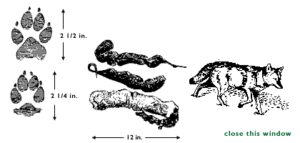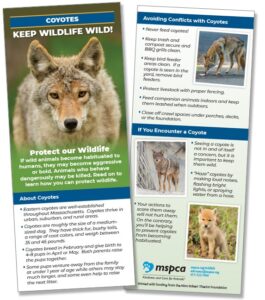-
Adopt
-
Veterinary Care
Services
Client Information
- What to Expect – Angell Boston
- Client Rights and Responsibilities
- Payments / Financial Assistance
- Pharmacy
- Client Policies
- Our Doctors
- Grief Support / Counseling
- Directions and Parking
- Helpful “How-to” Pet Care
Online Payments
Emergency: Boston
Emergency: Waltham
Poison Control Hotline
-
Programs & Resources
- Careers
-
Donate Now
Becoming comfortable around humans is extremely dangerous for wildlife, so it is important to do everything we can to prevent that from happening. Thanks to a generous grant from the Nion Robert Thieriot Foundation, the MSPCA is proud to be able to offer informational pamphlets on avoiding conflicts with coyotes AT NO CHARGE to any Massachusetts municipality. Learn more on how to request these pamphlets.
The coyote is a member of the canid family, which also includes foxes, dogs, and wolves. Eastern Coyotes moved into areas of Massachusetts in the 1950s, and now can be found in every town in the state. At first glance these coyotes resemble German Shepherds in shape and size. They are also often confused with red and gray foxes.
The Eastern Coyotes is larger than its western counterpart. They vary in size depending on location but generally are four to four and a half feet long including the tail, stand eighteen to twenty-five inches tall at the shoulder, and weigh twenty to fifty pounds. A coyote may be gray, brown or tan above and white or light-color underneath, with a straight, bushy tail.
Coyotes are adaptable and can live in a wide range of climates and conditions, from suburbia to wilderness, sea level to over ten thousand feet in altitude, and are now found in all states except Hawaii. They are territorial, the males marking their boundaries with urine, as do many canids. The size of the territory is directly related to the quality of the habitat, and often it can take several square miles to support a coyote family.
Coyotes are omnivorous and make use of an astonishing variety of plant and animal foods including garbage, insects, rodents, rabbits, birds, deer, carrion, and even berries and fruits. Coyotes play an important role in controlling rodents.
Coyotes breed during February or March and give birth in April or May. The litter size varies, depending in part upon environmental conditions and coyote population density. The pups nurse for up to two months, mature quickly, and are fully independent at about nine months. Some coyotes disperse within a year but others remain with the family unit for an additional year, often helping to raise the next litter.
In addition to coyotes that are part of a family unit, other transient coyotes roam by themselves — some may eventually replace an alpha female or male in a family unit.
Possible Conflicts and Solutions
Generally, coyotes are shy and avoid contact with humans. In urban and suburban areas, however, coyote may be less likely to fear people and more likely to associate them with an easy, dependable food source. Some have been known to come up to the doors of homes if food is regularly present. If you live in an area where there are coyote, it is important to supervise children and pets when they are outside. Make sure you are not inadvertently attracting coyotes by leaving out open trash containers, feeding pets outside, or leaving spilled bird seed on the ground, which can attract small rodents that then can attract coyotes. Learn more.
Many non-lethal strategies exist to discourage coyote predation on livestock, including guard animals (dogs, donkeys, llamas), smell and taste aversion substances, shock devices, noise devices, and portable fencing. Poultry and hobby livestock can be well-protected from coyotes with fencing (both structural and electric) and by ensuring that the animals are properly confined in well-built cages or pens each evening.
Public Health
Like all warm-blooded animals, coyotes may contract rabies.
Additional Information
- Coexisting with Coyotes
- Humane Conflict Solutions with Coyotes – Intruder Excluder
- MSPCA Coyote Fact Sheet
- The Humane Society of the United States Coyote Hazing Guidelines
- Coyote Killing Contests

Coyote Tracks and Scat
For more information, visit the Project Coyote and Eastern Coyote Research pages.





